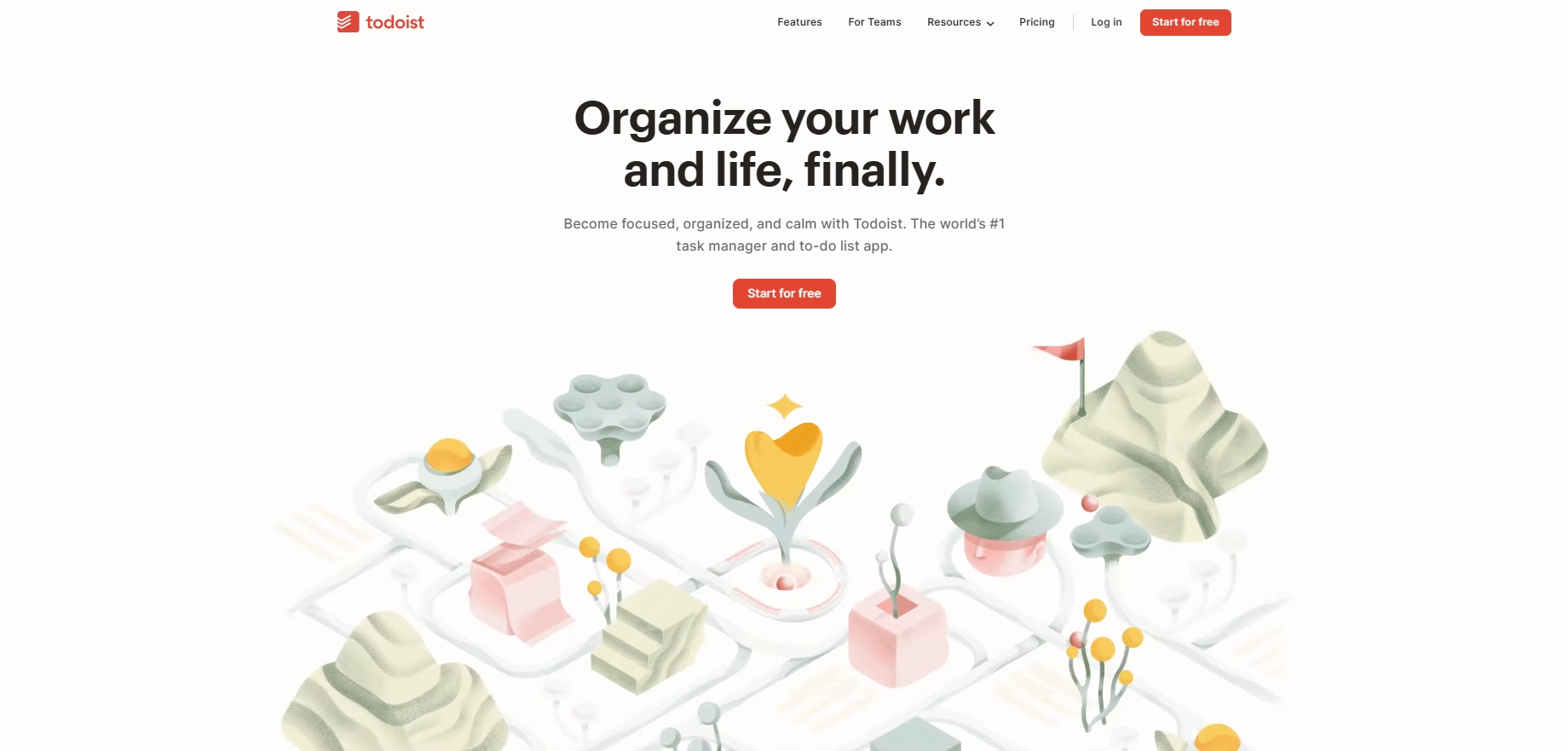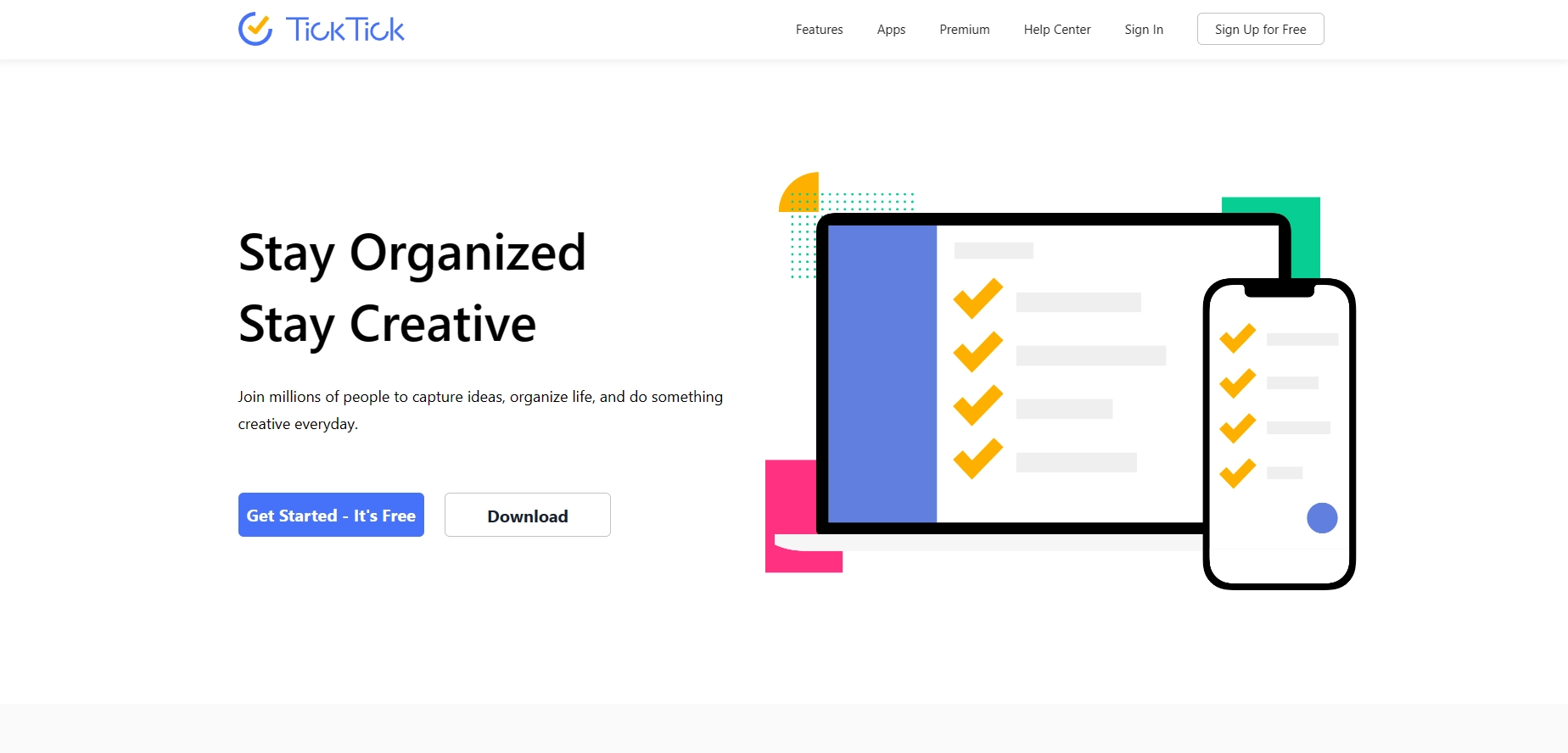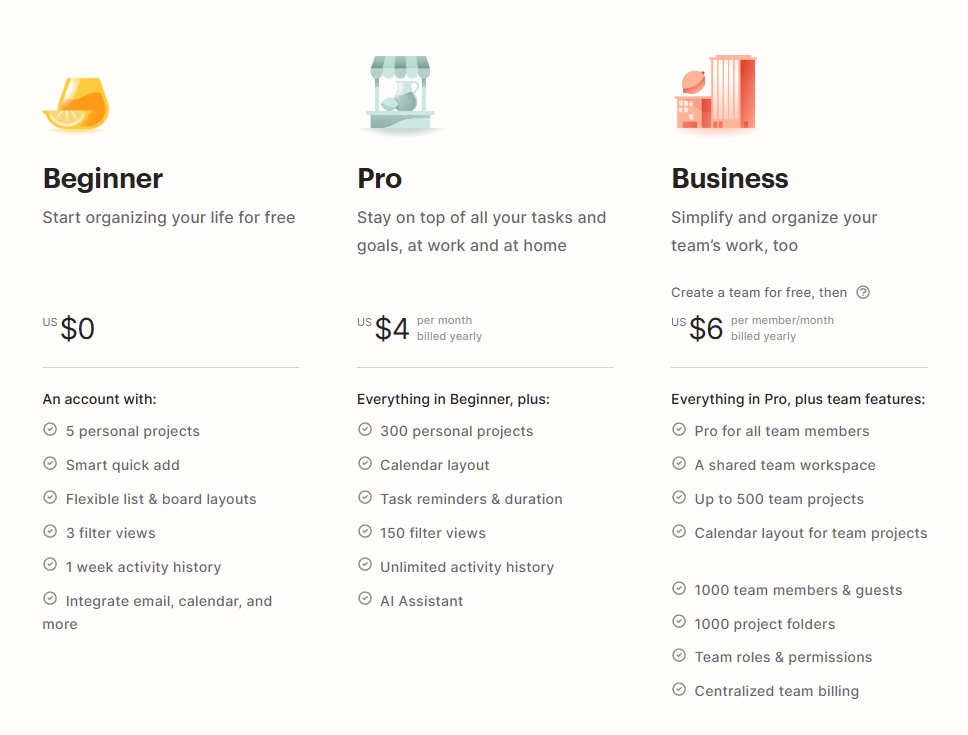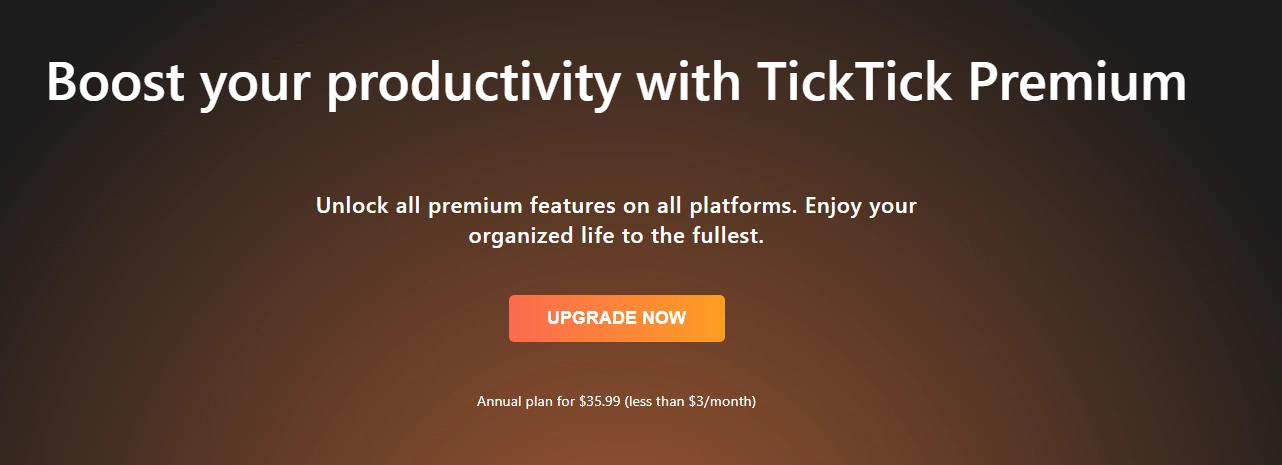In the world of management apps, Todoist and TickTick are two popular tools, each boasting a suite of features that promise to boost your productivity.
Todoist has long been known — and praised — for its simplicity and more advanced task organization capabilities, while TickTick has gained popularity thanks to its intuitive interface and versatility.
As more and more people look for a tool to help them manage their to-do lists, the debate between Todoist and TickTick intensifies.
This article will provide a comprehensive Todoist vs. TickTick comparison and help you choose an app that can meet all your productivity needs.
What is Todoist?
Todoist — one of the top productivity apps currently available on the market — is a powerful tool for managing your daily tasks and more complex projects, too.

It boasts a wide range of advanced features that simplify creating and prioritizing tasks, collaborating, and tracking progress while maintaining a simple, user-friendly interface. Plus, Todoist supports advanced project collaboration.
Todoist’s key features
You’ll notice that compared to other popular daily planning apps that focus on habit tracking and managing personal tasks, Todoist has a set of impressive features and capabilities — making it a great choice for managing team-based projects.
It’s no surprise that productivity apps like Todoist and Motion are becoming increasingly popular in the workplace:

With that said, here’s an overview of Todoist’s range of features:
- To-do list creation with a quick-add option, reminders, and recurring due dates
- Task management features with four priority levels, labels, the option to add sub-tasks, and task descriptions
- Flexible calendar views — including “Today” and “Upcoming” — and custom filters
- Different types of project views — including Calendar, list, and Kanban board options
- Collaboration features, including shared workspaces with up to 1,000 collaborators per project, comments, project sharing, different roles and permission levels, and the option to assign tasks
- Progress tracking with daily and weekly goals, activity history that can be filtered based on active projects and people, and an archive of completed tasks
- Todoist Karma, which adds a fun touch to basic task management by awarding points for every task you complete
- Team-based templates that make it easy to get started and speed up project planning, especially when dealing with larger projects
- AI Assistant that can automatically generate task lists, break larger projects down into bite-sized tasks, and offer suggestions on how to make your tasks more actionable and easier to complete
It’s also worth noting that Todoist boasts cross-platform availability. That means you can keep track of your tasks and projects across a wide range of platforms and devices — from desktop to Android and iOS. Plus, it’s available as a browser extension and an email add-on.
Last but not least, Todoist integrates with more than 80 other third-party apps — including communication, project management, file sharing, time tracking, and calendar integration. You can integrate Todoist with your Google Calendar, Microsoft Teams, Slack, Outlook, Gmail, and automation platforms like Zapier and IFTTT.
Read more: Stop using to-do list apps like Todoist and TickTick
What is TickTick?
Like Todoist, TickTick’s suite of features is designed to streamline task management and boost productivity.

It makes it easy to add new tasks and gives users access to daily and monthly calendar views — ensuring comprehensive insight into their scheduling and planning activities. Plus, it doubles as a habit tracker — something you won’t get with Todoist.
TickTick’s key features
With intuitive task creation, flexible calendar views, a user-friendly interface, and customization options, TickTick simplifies task management and caters to a wide range of users — especially those looking to improve their personal productivity.
Here’s an overview of TickTick’s main features:
- Flexible calendar views that show a preview of your daily, weekly, or monthly tasks — along with additional filters — and provide clarity regarding your schedule and upcoming tasks
- Simple task creation, with the option to add tasks via voice input or email inbox
- Task management features, such as setting due dates, task duration, and different types of reminders (including location-based reminders), and the option to add recurring tasks
- Four levels of to-do lists — including folders, lists, tasks, and check items — with tags, four priority levels, sorting, and built-in search for more efficient organization
- Built-in Pomo Timer — great for those who prefer to use the Pomodoro Technique and want to break down their tasks into focused intervals with short breaks — with optional white noise
- Basic team collaboration features — including sharing lists with others, assigning tasks, and viewing task activities — for improved coordination, task delegation, and progress tracking
It has a limited integration possibility — especially compared to Todoist — but still allows users to connect TickTick with popular apps and platforms, including Zapier, IFTTT, Gmail, Outlook, Slack, Amazon Alexa, and Google Assistant.
One thing that TickTick has in common with Todoist is cross-platform availability. The app has a desktop version available on Windows, Mac, and Linux, a mobile app for Android and iOS users, and a browser extension for Chrome, Microsoft Edge, and Firefox. In short, you can use TickTick on virtually any platform.
What sets TickTick apart from competitors like Todoist is the unique habit-tracking feature:
Unlike many other task management platforms, TickTick allows users to create and monitor their daily habits. That adds a new layer to personal productivity and goal achievement by helping users track their progress, maintain consistency — and, most importantly, hold themselves accountable.
Todoist vs. TickTick: User interface and ease of use
You’ll notice that both project management apps follow a relatively similar layout and boast an intuitive user interface — but visually speaking, there’s a notable difference in the overall look and feel of the two apps.

Todoist — one of the leading productivity apps designed to provide comprehensive task oversight — adopts a more visually engaging interface and packs a wide range of powerful features for a structured approach to task management and progress tracking.
Compared to Todoist, TickTick appears more minimalist and straightforward — with leading options and active task lists on the left and task details on the right. The clean interface adds to the user experience, making the app easy to navigate — even for a first-time user.
Another thing that Todoist and TickTick have in common is customization options. Both apps allow you to change the default theme and add a personal touch to the interface:
With Todoist, you can choose among eight different themes — four of which are free. TickTick takes customization to a new level, allowing users to set beautiful custom backgrounds and choose among more than ten premium themes.
While this is a highly subjective choice, TickTick offers a bit more flexibility in customizing the app’s appearance.
Todoist vs. TickTick: Pricing
One thing that Todoist and TickTick have in common pricing-wise is that both time management apps have a free version.
With Todoist’s free-forever Beginner plan, users can access basic task management features, including up to five personal projects with due dates and priority levels, file uploads with a 5MB size limit, and popular integrations.
However, there’s no calendar layout, auto backups are limited, and you get a one-week activity history — with no access to Todoist’s AI assistant.

It doesn’t include any bells and whistles, but it’s enough to cover the basics of task organization.
On that note, there’s also a premium version of the app. So, if you need access to additional features, you can choose between two monthly plans:
- Pro plan, which starts at $4 per user per month
- Business plan, which starts at $6 per user per month
Like Todoist, TickTick has a free version. This basic plan includes Smart Lists with comments and tags, a weekly overview of your upcoming tasks, and a separate tab for complete tasks. You’ll need to upgrade to a premium plan to access Calendar View, progress tracking, and filters.

It’s worth mentioning that TickTick is marginally cheaper than Todoist — with the annual plan starting at $35.99. So, if you’re looking for a budget-friendly task management tool, TickTick would be a better choice.
Which one should you pick?
The choice between Todoist and TickTick ultimately comes down to your specific needs and preferences.
Todoist is more oriented toward collaborative task management:
It boasts collaborative features, extensive customization options, popular integrations, and support for up to 1,000 collaborators per project. Plus, you get everything your team needs to stay organized and streamline your workflow — including customizable project boards, intricate task hierarchies, reminders, recurring due dates, sub-tasks, and project templates — with Todoist's AI Assistant helping with task generation and optimization.
On the other hand, TickTick — with its intuitive interface and advanced habit-tracking features — is ideal for monitoring daily habits and boosting personal productivity. The daily and monthly calendar views, simple task creation, and built-in Pomo Timer all contribute to efficient task management.
So, while TickTick may lack the extensive collaboration features of Todoist, the focus on habit stats and budget-friendly pricing make this to-do list app a compelling option for individuals seeking to improve personal productivity and achieve their goals.
Ultimately, if you prioritize team collaboration and customization options and want a tool that can handle complex projects, Todoist is a better choice. However, if you want a user-friendly habit tracker with an integrated calendar and a reasonably priced premium plan, TickTick is the way to go.
Motion - The best alternative to Todoist and TickTick
The task management software market is expected to reach $2.75 billion by 2029 — based on a predicted compound annual growth rate (CAGR) of 20.8%. That is to say, there’s an increased need for real-time visibility into entire project schedules, team collaboration, and more efficient task management.

Now, at this point, you can probably tell that Todoist and TickTick have a lot to offer in terms of helping you stay organized and complete your tasks on time — and each app has an extensive array of features and capabilities.
Todoist — the more advanced solution of the two — is better suited for collaborative task management. TickTick, on the other hand, clearly prioritizes simplicity and user-friendliness. Moreover, it’s a relatively affordable tool.
But what if neither Todoist nor TickTick meets your needs?
If so, you should consider an AI-powered productivity tool like Motion.
Here’s a quick overview of Motion’s most notable features and capabilities — just to give you an idea of what makes it the best all-in-one productivity apps currently available on the market:
- Task Manager, with capabilities that include one-click task input and the option to add notes and create recurring tasks
- Built-in calendar functionality, with automatic time blocking and the option to combine your personal and work calendars in one place
- Project Manager tool with workspaces, templates, and different types of project views, including board and list view
- AI Meeting Assistant that handles scheduling on your behalf
Motion offers various integration options with other popular third-party apps, including Microsoft Outlook 365, Gmail, Google Calendar, Microsoft Teams, Zoom, and Zapier.
While Motion doesn’t have a free version, it offers a 7-day trial — so you can still try it out free of cost and see what it can do for your productivity levels. And if you’re ready to sign up, you can choose between two monthly plans:
- Individual plan, which costs $19 per month
- Team plan, which costs $12 per month per user
Conclusion
The Todoist vs. TickTick comparison ultimately depends on your preferences and specific productivity needs.
Todoist is known for offering a more robust approach to task management and an array of customization options. On the other hand, TickTick provides a user-friendly experience and can be a great choice for budget users.
But have you considered using an AI-powered task management app to boost productivity and optimize workflow?
If so, be sure to consider Motion:
Powered by advanced AI capabilities, Motion is designed to simplify task planning and meeting scheduling, ultimately boosting productivity.
Start your free 7-day trial — and see how Motion can help you manage your schedule.

Dejan is a versatile, experienced content marketer who enjoys captivating storytelling, turning keywords into engagement. He's a coffee aficionado, always brewing the perfect cup for writing marathons.
![Todoist vs. TickTick: Which App Is Better? [2025]](/cdn-cgi/image/onerror=redirect,width=568,height=316,format=webp/https://cdn.sanity.io/images/4jvom4yf/production/8b2fe85696a90c25765dfde45d4375c5a977aeff-1400x780.webp)



